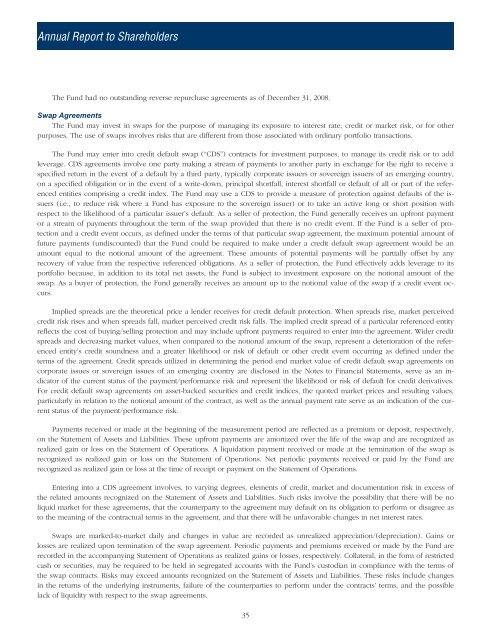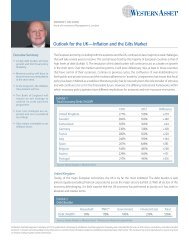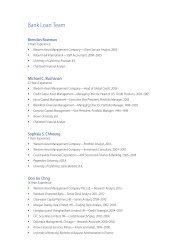Investment Commentary and Annual Report to ... - Western Asset
Investment Commentary and Annual Report to ... - Western Asset
Investment Commentary and Annual Report to ... - Western Asset
You also want an ePaper? Increase the reach of your titles
YUMPU automatically turns print PDFs into web optimized ePapers that Google loves.
<strong>Annual</strong> <strong>Report</strong> <strong>to</strong> ShareholdersThe Fund had no outst<strong>and</strong>ing reverse repurchase agreements as of December 31, 2008.Swap AgreementsThe Fund may invest in swaps for the purpose of managing its exposure <strong>to</strong> interest rate, credit or market risk, or for otherpurposes. The use of swaps involves risks that are different from those associated with ordinary portfolio transactions.The Fund may enter in<strong>to</strong> credit default swap (“CDS”) contracts for investment purposes, <strong>to</strong> manage its credit risk or <strong>to</strong> addleverage. CDS agreements involve one party making a stream of payments <strong>to</strong> another party in exchange for the right <strong>to</strong> receive aspecified return in the event of a default by a third party, typically corporate issuers or sovereign issuers of an emerging country,on a specified obligation or in the event of a write-down, principal shortfall, interest shortfall or default of all or part of the referencedentities comprising a credit index. The Fund may use a CDS <strong>to</strong> provide a measure of protection against defaults of the issuers(i.e., <strong>to</strong> reduce risk where a Fund has exposure <strong>to</strong> the sovereign issuer) or <strong>to</strong> take an active long or short position withrespect <strong>to</strong> the likelihood of a particular issuer’s default. As a seller of protection, the Fund generally receives an upfront paymen<strong>to</strong>r a stream of payments throughout the term of the swap provided that there is no credit event. If the Fund is a seller of protection<strong>and</strong> a credit event occurs, as defined under the terms of that particular swap agreement, the maximum potential amount offuture payments (undiscounted) that the Fund could be required <strong>to</strong> make under a credit default swap agreement would be anamount equal <strong>to</strong> the notional amount of the agreement. These amounts of potential payments will be partially offset by anyrecovery of value from the respective referenced obligations. As a seller of protection, the Fund effectively adds leverage <strong>to</strong> itsportfolio because, in addition <strong>to</strong> its <strong>to</strong>tal net assets, the Fund is subject <strong>to</strong> investment exposure on the notional amount of theswap. As a buyer of protection, the Fund generally receives an amount up <strong>to</strong> the notional value of the swap if a credit event occurs.Implied spreads are the theoretical price a lender receives for credit default protection. When spreads rise, market perceivedcredit risk rises <strong>and</strong> when spreads fall, market perceived credit risk falls. The implied credit spread of a particular referenced entityreflects the cost of buying/selling protection <strong>and</strong> may include upfront payments required <strong>to</strong> enter in<strong>to</strong> the agreement. Wider creditspreads <strong>and</strong> decreasing market values, when compared <strong>to</strong> the notional amount of the swap, represent a deterioration of the referencedentity’s credit soundness <strong>and</strong> a greater likelihood or risk of default or other credit event occurring as defined under theterms of the agreement. Credit spreads utilized in determining the period end market value of credit default swap agreements oncorporate issues or sovereign issues of an emerging country are disclosed in the Notes <strong>to</strong> Financial Statements, serve as an indica<strong>to</strong>rof the current status of the payment/performance risk <strong>and</strong> represent the likelihood or risk of default for credit derivatives.For credit default swap agreements on asset-backed securities <strong>and</strong> credit indices, the quoted market prices <strong>and</strong> resulting values,particularly in relation <strong>to</strong> the notional amount of the contract, as well as the annual payment rate serve as an indication of the currentstatus of the payment/performance risk.Payments received or made at the beginning of the measurement period are reflected as a premium or deposit, respectively,on the Statement of <strong>Asset</strong>s <strong>and</strong> Liabilities. These upfront payments are amortized over the life of the swap <strong>and</strong> are recognized asrealized gain or loss on the Statement of Operations. A liquidation payment received or made at the termination of the swap isrecognized as realized gain or loss on the Statement of Operations. Net periodic payments received or paid by the Fund arerecognized as realized gain or loss at the time of receipt or payment on the Statement of Operations.Entering in<strong>to</strong> a CDS agreement involves, <strong>to</strong> varying degrees, elements of credit, market <strong>and</strong> documentation risk in excess ofthe related amounts recognized on the Statement of <strong>Asset</strong>s <strong>and</strong> Liabilities. Such risks involve the possibility that there will be noliquid market for these agreements, that the counterparty <strong>to</strong> the agreement may default on its obligation <strong>to</strong> perform or disagree as<strong>to</strong> the meaning of the contractual terms in the agreement, <strong>and</strong> that there will be unfavorable changes in net interest rates.Swaps are marked-<strong>to</strong>-market daily <strong>and</strong> changes in value are recorded as unrealized appreciation/(depreciation). Gains orlosses are realized upon termination of the swap agreement. Periodic payments <strong>and</strong> premiums received or made by the Fund arerecorded in the accompanying Statement of Operations as realized gains or losses, respectively. Collateral, in the form of restrictedcash or securities, may be required <strong>to</strong> be held in segregated accounts with the Fund’s cus<strong>to</strong>dian in compliance with the terms ofthe swap contracts. Risks may exceed amounts recognized on the Statement of <strong>Asset</strong>s <strong>and</strong> Liabilities. These risks include changesin the returns of the underlying instruments, failure of the counterparties <strong>to</strong> perform under the contracts’ terms, <strong>and</strong> the possiblelack of liquidity with respect <strong>to</strong> the swap agreements.35





